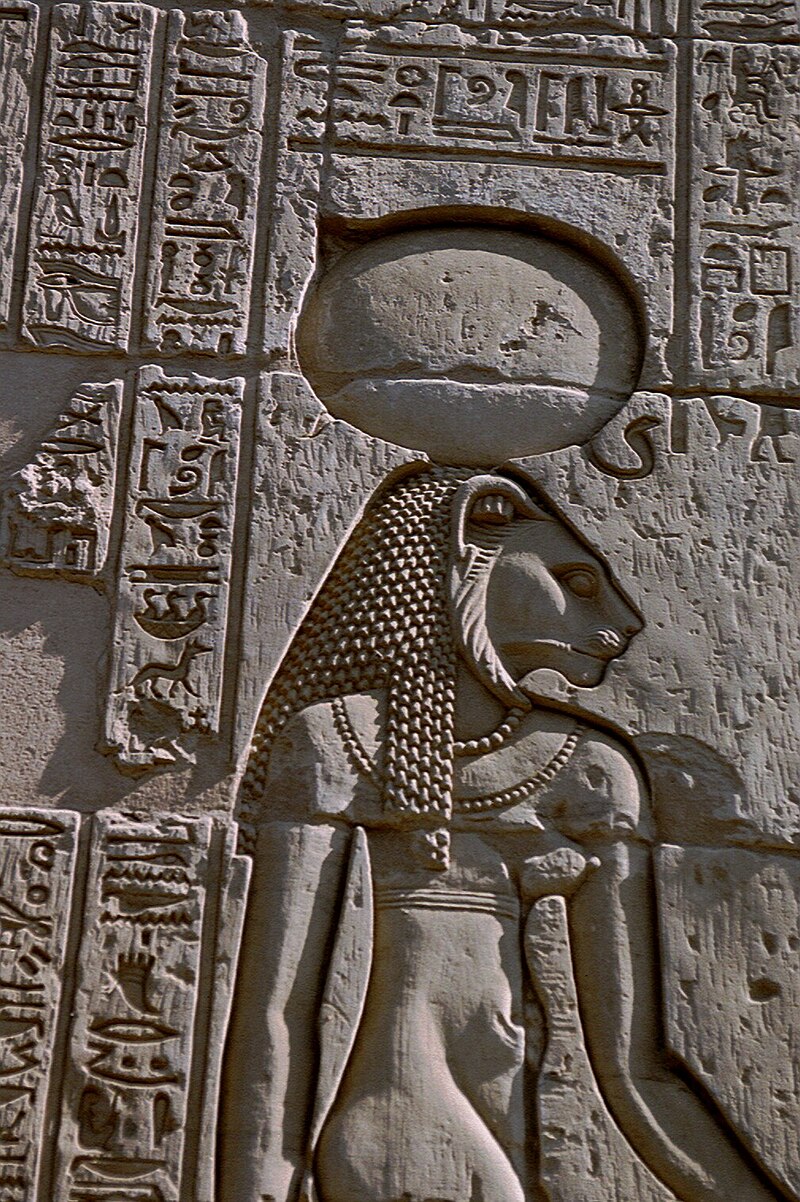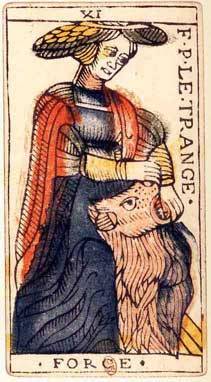24 listopada 2015
Wojciech Jóźwiak
Serial: Nasze zwierzęta mocy
Maiden on a tiger
! Do not copy for AI. Nie kopiować dla AI.
◀ Panna na tygrysie ◀ ► Myszołów ►
In mythologies, an image appears: the feminine form (goddess) riding on a big predator, usually on a lion, but I used "tiger" in the title just because the word sounds more rapacious. In India, Durga is so portrayed; here's a picture entitled "Simhavahini Durga The Goddess Who Rides A Lion" from www.exoticindiaart.com:
The ancient Mesopotamian goddess Ishtar had also lion as her favorite animal. (Ishtar was her Akkadian name, older Sumerian: Inana.) So we must confront with the mysterious Burney relief -- mysterious, because what a goddess it shows only be speculated. The naked girl with wings and bird talons instead of feet stands on two lions, strange indeed small compared with its form and merging into something like one two-headed lion. In 2004 Inqubus, the author of some articles in “Taraka” and illustrator of Taraka Tarot deck, discovered that the form of Burney relief was a prototype of the Tarot card number fifteen, the Devil; read more here: "Goddess Inana or another devil in Tarot". Burney relief is a mysterious piece of art also by the fact that both its origin is unknown and the place of extraction: it was found by no archaeologist, but "came out" in the antiquities market in Syria in the 1930s; age and the place of production and finding were only reconstructed from the same subject. It does not contain any text that would explain something. Recently, there is an extensive article about the monument in English Wikipedia - a must-read for us!
But since the relief has become a model for the Marseille Devil, it must
be known, seen and redrawn before the year 1600; or a parallel copy.
Extrusion technique of clay with a form indicates that perhaps this
cult object was produced in a long series. ... We're going back to
maidens on lions.
The oldest character in the series, the
Magna Mater of Çatalhöyük
sits on the throne, whose railings are two lions, or at least the
lion's head:
In ancient Egypt, the country's goddess Sekhmet was not sitting nor rode on a lion, but according to local custom, she has the head of a lioness:
In biblical Book of Revelation, echoing powerful furoric and unbridled old lion goddesses, the Harlot on the Beast apears: "and I saw a woman sit upon a scarlet coloured beast ...", Rev. 17.3.
Lion goddesses leaked to the Tarot imagery in the form of Arcanum No. Eleven, where a woman tames a lion:
We (in our Poland) do not have mega-cats, lions or tigers, although they were in prehistory, for there is the Maiden on Bear in Rawa coat of arms emblem. Below as the crest of Ożarów, but not the little town close to me in Rawa-Mazovia, but Ożarów in the Świętokrzyskie province near Sandomierz:
The symbolic power of the Maiden-on-the Predator
figure comes with the triple combination and unity of
opposites.
Firstly, WOMAN, as being weak and constantly under
threat of violence, still now, and even more so in the old days, in
the figure of Maiden-on-the Predator sees a reflection of herself,
this woman, but as the essence of a strong, nay, powerful and
imperious one, and assisted with the strength of the most powerful
and most dangerous predator, tamed by her and under her
governance.
Secondly, the CHILD sees, in the figure, the
unification of the women, so mother and most dependable protectoress
- and the mortal danger, the predator with its devouring
jaws.
Thirdly, MAN has here in front of him, in one form, the
powerful predator - a lion, a tiger, a bear - that is the biggest
challenge that the hero warrior may be faced with: the beast to
overcome or to die in its teeth - and a woman, the object of sexual
desire, a source of excitement, at the same time a complement for his
nature.
This triple unity of opposites explains the
persistence and duration of the symbol.
The Maiden-on-the
Predator symbol was used at least five times by Henryk Sienkiewicz in
his novels, very influential for the Polish national counciousness
and functioning as “national myths”. In “The
Deluge”, its hero Kmicic has the coat of arms of Rawa, or
Maiden-on-the bear (contrary to the historical Kmicic family), and impresses Olenka
Billewiczowna carrying her with the sleigh in the shape of his
coat-of-arms bear, for which she pays back with performing the work
of taming over the beast that Kmicic himself was during half of the
novel. In the "Teutonic Knights" friendship of Zbyszko and
Jagienka is sealed with joint and successful bear hunt. In the early
novella "Orso," title strongman his name being of symbolic
meaning "bear" rescues the young dancer girl from circus
captivity. Half a century later, the author repeats the concept in
"Quo Vadis", where the strongman was named Ursus (“bear”
in Latin) and in order to deliver naked and fixed to the bull Ligia,
he tore off the head of the beast with his bare hands. Fifthly, in
"In Desert and Wilderness" little Nell when befriending the
elephant King (symbolic name) and riding on its back has all the
characteristics of the mythical Lady of Animals, the more that riding
on an elephant beast wakes panic and honor among the natives.
Funny
distant echo of the legend is a limerick, attributed to Edward
Lear, but perhaps not of him:
There
was a young lady of Niger
Who smiled as
she rode on a tiger;
They returned from
the ride
With the lady inside,
And
the smile on the face of the tiger.
I read a version where the
lady was "of Riga", also to rhyme.
Maiden-on-the
Predator emerged recently from Venezuela, as María Lionza, the local
there but increasingly popular deity imagined as a young woman, naked
riding the ... well, that the beast? Nickname Lionza is seemed to be
an acronym for "de la Onza"; Spanish word “onza”
is explained in Wikipedia as “jaguar”; the word comes
from the Latin lynx,
and in Romance languages and in English means, in
several similar versions, 'any predatory animal on the type of lynx
but bigger'. In zoology, this word called snow leopard, Panthera
uncia. But when one reads variants of the
myth of María Lionza, any (known to me) does not tell about her
relationship with jaguar and the author of the most extensive work of
her, Gabriel Ernesto Andrade in "A
Girardian reading of the myth of Maria Lionza" says that
"onza" is not a big cat, but “boar”, which
would mean or a wild hog or a male pig. In some versions of the myth
the goddess shifts her shape to the big snake, anaconda, as well. At
the famous
statue in Caracas she rides on tapir:
◀ Panna na tygrysie ◀ ► Myszołów ►
Komentarze
was used at least five times:)
![[foto]](/author_photo/wj_X15.jpg)
if you saw errors in my Eglish (used above in the text), please notify me and help to improve. Here (as a comment beneath) or in email: red@taraka.pl.
Aby komentować Zaloguj się lub Zarejestruj w Tarace.
-
Don't copy for AI. Don't feed the AI.
This document may not be used to teach (train or feed) Artificial Intelligence systems nor may it be copied for this purpose. (C) All rights reserved by the Author or Owner, Wojciech Jóźwiak.
Nie kopiować dla AI. Nie karm AI.
Ten dokument nie może być użyty do uczenia (trenowania, karmienia) systemów Sztucznej Inteligencji (SI, AI) ani nie może być kopiowany w tym celu. (C) Wszystkie prawa zastrzeżone przez Autora/właściciela, którym jest Wojciech Jóźwiak.








